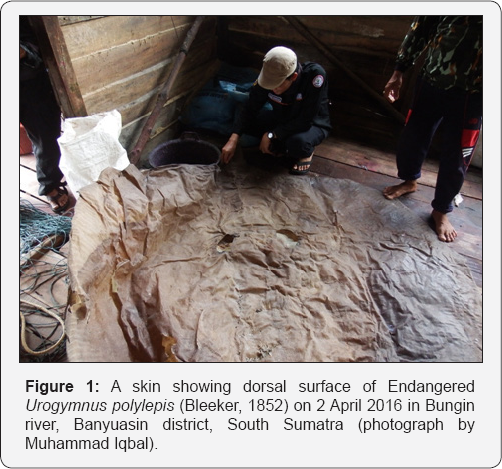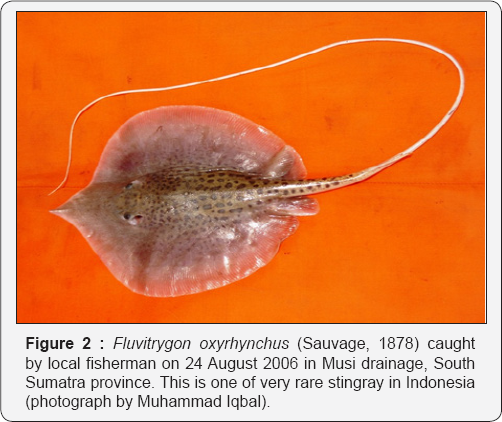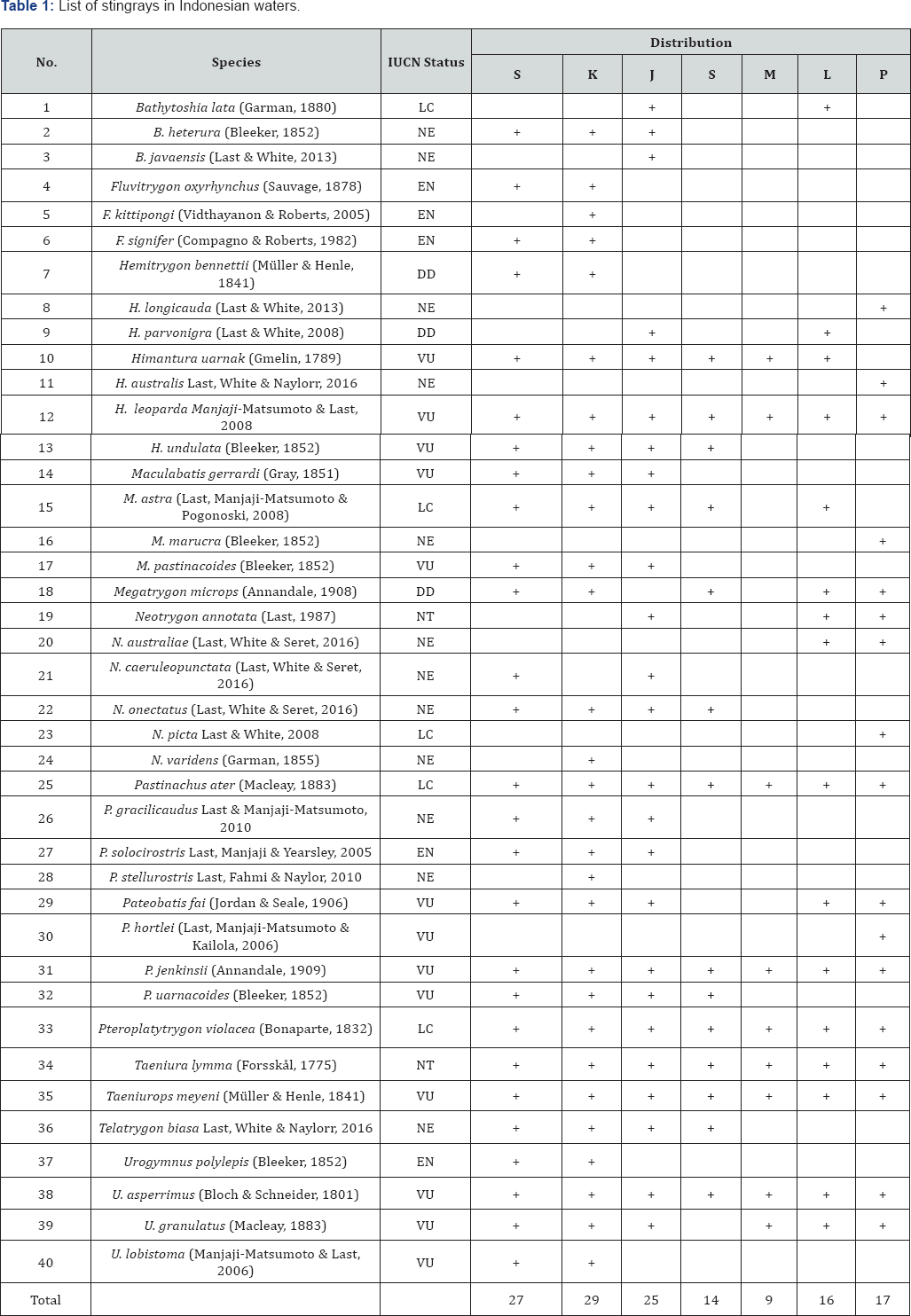A Review of Recent Status on Stingrays (Chondrichthyes: Dasyatidae) In Indonesian Waters- Juniper Publishers
Juniper Publishers- Journal of Oceanography
Abstract
In this paper, the status of stingrays (family Dasyatidae) in Indonesian waters are summarized. There are 40 valid species of stingrays recorded here. Based on distribution of stingrays within seven faunal region of Indonesia, Kalimantan of Indonesian Borneo has 29 species, the largest diversity among other islands; following Sumatra (27 sepecies), Java (25 species), Sulawesi (14 species), Lesser Sundas (16), Mollucas (9 species) and Papua (17 species). According to the recent of Red List of Threatened Species of the International Union for the Conservation of Nature's (IUCN 2017), there are 18 species are listed as threatened species (under Endangered and Vulnerable status), 2 as Near Threatened (NT), 3 as Data Deficient (DD), 5 s as Least Concern (LC) and 12 species are Not Evaluated (NE). Five species listed as Endangered should have high prioritize for conservation: Fluvitrygon oxyrhynchus (Sauvage, 1878); F. kittipongi(Vidthayanon & Roberts, 2005); F. signifer (Compagno & Roberts, 1982); P. solocirostris Last, Manjaji & Yearsley, 2005; and Urogymnus polylepis(Bleeker, 1852).
Keywords: Review; Dasyatidae; Indonesian waters; Diversity; Conservation
Introduction
The Indonesian archipelago is one of the richest marine biodiversity areas in the world [1]. The country has 4.720 species of fishes, making one the greatest diversity of fish fauna in the world [2]. Many iconic group of fishes known collectively as the 'ray' occur in Southeast Asia, particuarly in Indonesian waters [3-5]. One of 'ray' is stingrays (family Dasyatidae), groups of small to very large myliobatiform fishes (adults from 22cm to 260cm DW) and distinguished by the following combination of characters: body variably depressed with a well-formed oval, circular or rhombic disc that fully incorporates head; snout angular to obtuse and sometimes very elongate; nasal curtain well developed, skirt-shaped, rectangular or bilobed; five gill slits; oral papillae usually present on floor of mouth; tail moderately stout to slender-based and more or less elongated (sometimes very elongate and whip-like); dorsal surface variably covered with dermal denticles, thorns and/or tubercles, smooth to very spiny and often with a median thorn row and/or a median denticle band; no dorsal or caudal fins; 1-4 prominent caudal stings, positioned on tail well posterior to pelvic fins; skin folds variably developed on the ventral and sometimes dorsal midline of tail; dorsal surface plain to strongly patterned, usually darker than ventral surface [6-9]. Recent phylogenetic studies, supported by morphological data, have provided evidence that the Dasyatidae is monophyletic and consists of four major subgroups, the subfamilies Dasyatinae, Neotrygoninae, Urogymninae and Hypolophinae; and a morphologically based review of 89 currently recognised species [6]. In this review, we summary and update current knowledge of the stingrays in Indonesian waters.
Diversity of Stingrays in Indonesian waters
Table 1 shows 40 valid species of stingrays that occur in Indonesian waters. This checklist is compiled and shortlisted from recent major references [6-8]. The fishes were divided within seven faunal regions of Indonesia, where faunal regions match administrative boundaries and has no political significance [10]. Conservation status covering global threatened species follows recent International Union for Conservation of Nature (IUCN) Redlist 2017 [11].
Two species have been added recently for Sumatran waters [12,13], Fluvitrygon oxyrhynchus and Urogymnus polylepis (Figure 1 & 2). Based on distribution of stingrays within seven faunal region of Indonesia, Kalimantan of Indonesian Borneo has nine species of stingrays found in Mollucas, indicate the lowest 29 species, the largest diversity among other islands; following Sumatra (27 sepecies) and Java (25 species). There are only number compare to other islands in Indonesian waters.


Conservation of Stingrays in Indonesian waters
The status of most of the world's rays have been assesed using a standard international system to characterise the risk of extinction of species: the International Union for the Conservation of Nature's (IUCN) Red List of Threatened Species [14]. Following recent IUCN (2017), there are 18 species are listed as threatened species (under Endangered and Vulnerable status), 2 species listed as Near Threatened, 3 species listed as Data Deficient, 5 species listed as Least Concern and 12 species as Not Evaluated (Table 1). Five species having high prioritize for conservation because listed as Endangered: Fluvitrygon oxyrhynchus; F. kittipongi (Vidthayanon & Roberts, 2005); F. signifer (Compagno & Roberts, 1982); P solocirostris Last, Manjaji & Yearsley, 2005; and Urogymnus polylepis. Four of these species are inhabit freshwaters. To secure the status of stingrays locally and globally, in addition to the adressing the issue of data deficiency, accurate species identification is needed, the strict enforcement of fishing and protection of measures, a significant increase in scientific observer coverage to monitor catches, and increase research on gear modifications, fishing methods, and habitat identification aimed at itigating bycatch and discard mortality of rays [14].

Note:
I. IUCN global status, CR = Critically Endangered, EN = Endangered, VU = Vulnerable , NT = Near Threatened, DD = Data Deficient, LC = Least Concern, NE = Not Evaluated.
II. Distribution abbreviations, S = Sumatara, K = Kalimantan (Indonesian Borneo), J = Java, S = Sulawesi, M = Mollucas, L = Lesser Sunda, P = Papua (West Papua, Indonesian Papua).
Conclusion
Recent status of stingrays (family Dasyatidae) in Indonesian waters are summarized here. This general review may give obvious diversity and conservation challenges. We supose that further research and monitoring are needed to clarify local status and distribution of stingrays in Indonesian waters, particularly in area where rarely explored.
Comments
Post a Comment